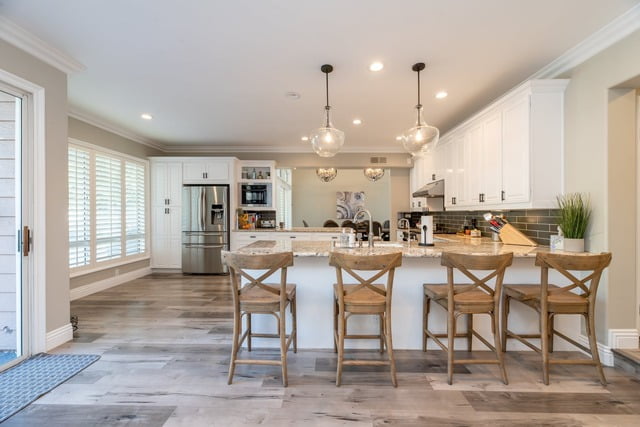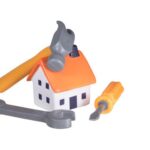What is the best way to get a home improvement loan? Whether you are looking to renovate your kitchen, upgrade your bathroom, or add an extra room to your home, the cost of these projects can quickly add up. In this article, we will explore the different options available for obtaining a home improvement loan and provide tips on how to navigate the process successfully.
Many homeowners find themselves in need of financial assistance when it comes to making improvements to their homes. This could be due to unforeseen repairs, desire for updates, or simply wanting to increase the value of their property. Understanding the need for a home improvement loan is the first step in embarking on this journey.
In order to make informed decisions about obtaining a home improvement loan, it is crucial to assess your financial situation, research loan options, compare lenders, consider government programs, gather required documents, apply for the loan, and manage it responsibly. These steps will help ensure that you are well-equipped with the knowledge needed to secure the right loan for your specific needs and handle it wisely in order to avoid financial pitfalls.
Assessing Your Financial Situation
Evaluating Your Budget
Before applying for a home improvement loan, it is crucial to take a close look at your budget. Assess your monthly income and expenses to determine how much you can comfortably afford to borrow and repay. Consider your existing debts, savings, and emergency funds as well. Understanding your financial situation will help you make informed decisions about the type and amount of loan that best suits your needs.
Calculating Your Home’s Equity
Another important factor in assessing your borrowing needs is determining the equity in your home. The equity is the difference between the current market value of your home and the outstanding mortgage balance. Knowing this will help you understand how much you could potentially borrow using your home as collateral, through options like a home equity loan or a home equity line of credit (HELOC).
Considering Your Credit Score
Your credit score plays a significant role in determining your borrowing abilities. Lenders use this score to assess your creditworthiness and determine the interest rate on any loan you apply for. It’s important to review your credit report for any errors or discrepancies that could be negatively impacting your score. Improving your credit score before applying for a home improvement loan can help you qualify for better terms and lower interest rates.
By carefully evaluating these factors, you can determine how much you need to borrow for your home improvement project and what type of loan aligns with your financial capabilities. Making informed decisions during this assessment phase will set the foundation for a successful loan application process.
Researching Loan Options
When considering a home improvement project, it’s important to explore the different types of loans available to finance your renovation. Here are some common options to consider:
- Personal Loans: These unsecured loans can be used for a variety of purposes, including home improvements. They typically have fixed interest rates and repayment terms, making them a straightforward option for financing your project.
- Home Equity Loans: If you have significant equity in your home, you may qualify for a home equity loan. This type of loan uses your home as collateral and typically offers lower interest rates than personal loans. However, it’s important to carefully consider the risks of using your home as collateral before pursuing this option.
- Home Equity Line of Credit (HELOC): Similar to a home equity loan, a HELOC also uses your home as collateral but operates as a revolving line of credit with a variable interest rate. This can be a flexible option for financing ongoing or unpredictable costs associated with your home improvement project.
- Cash-Out Refinance: If you have built up equity in your home, you may be able to refinance your mortgage and take out cash for your renovation project. Keep in mind that this option essentially replaces your existing mortgage with a new one, so it’s important to carefully consider the long-term financial implications.
It’s essential to carefully consider each loan option and assess which best aligns with your financial situation and renovation needs. Researching loan options thoroughly will help you make an informed decision when it comes to financing your home improvement project.
Comparing Lenders
When it comes to obtaining a home improvement loan, one of the most crucial steps in the process is comparing lenders. Evaluating the best financial institutions and online lenders for home improvement loans can make a significant difference in terms of interest rates, repayment terms, and overall customer satisfaction. Here are some key factors to consider when comparing lenders for a home improvement loan:
- Interest Rates: One of the most important factors to consider when comparing lenders is the interest rate they offer. Be sure to research and compare the interest rates offered by different financial institutions and online lenders.
- Repayment Terms: It’s essential to look at the repayment terms offered by each lender. Some lenders may offer more flexibility in terms of repayment options, such as longer loan terms or the ability to make bi-weekly payments.
- Customer Reviews: Researching customer reviews and feedback can provide valuable insight into the overall experience of working with a particular lender. Look for reviews on reputable websites and forums to get a sense of customer satisfaction.
In addition to traditional financial institutions, there are also online lenders that specialize in home improvement loans. These online lenders may offer competitive interest rates and flexible repayment terms, making them worth considering alongside traditional banks and credit unions. Be sure to thoroughly research each lender’s reputation, terms, and customer service before making a decision.
When comparing lenders for a home improvement loan, it’s crucial to shop around and gather quotes from multiple sources. By taking the time to compare different options, you can ensure that you find the best possible loan for your specific needs and financial situation.
Considering Government Programs
Understanding Government-Sponsored Loan Programs
Government-sponsored loan programs are designed specifically to help homeowners fund their home improvement projects. These programs may be offered at the federal, state, or local level and can provide borrowers with favorable terms and lower interest rates compared to traditional lenders. Some programs may also have specific requirements, such as being income-based or targeted towards certain types of home improvements.
Exploring Eligibility Requirements
Before considering a government-sponsored loan program for home improvements, it’s important to understand the eligibility requirements. Some programs may have strict income limits, while others may require homeowners to meet certain criteria related to their property or the type of improvements being made. Researching and understanding these eligibility requirements beforehand can help homeowners determine if they qualify for these specialized loan programs.
Weighing the Benefits and Drawbacks
While government-sponsored loan programs can offer attractive benefits such as lower interest rates and flexible repayment terms, there are also drawbacks to consider. Some programs may have a lengthy application process or limited funding availability, which could delay the approval and disbursement of funds for a home improvement project. Homeowners should carefully weigh the benefits and drawbacks of these programs before deciding if they are the best option for financing their home renovations.
Gathering Required Documents
When applying for a home improvement loan, it is crucial to gather all the necessary documentation to support your application. Lenders require certain paperwork to verify your identity, income, and the details of the home improvement project. One of the most important documents needed is proof of income, which can include pay stubs, bank statements, or tax returns. This helps the lender assess your ability to repay the loan.
In addition to income verification, you will also need to provide details about the home improvement project. This may include contractor estimates, project plans, and specifications. Lenders want to ensure that the funds will be used for legitimate home improvements that will increase the value of the property. Another common requirement is proof of homeowners insurance, as lenders want to protect their investment in case of damage or loss to the property.
Furthermore, lenders will typically require personal identification such as a driver’s license or government-issued ID. This is needed to verify your identity and cross-check it with other documentation provided. Some lenders may also request additional documentation depending on their specific requirements or the type of loan being applied for. It’s important to inquire with potential lenders about any additional documents needed for a home improvement loan application.
| Documentation Required | Description |
|---|---|
| Proof of Income | Pay stubs, bank statements, or tax returns |
| Home Improvement Project Details | Contractor estimates, project plans, and specifications |
| Homeowners Insurance | Proof of insurance coverage |
| Personal Identification | Driver’s license or government-issued ID |
Applying for the Loan
When it comes to applying for a home improvement loan, it’s essential to be well-prepared and informed about the process. The first step in applying for the loan is to gather all the necessary financial documents. This may include proof of income, tax returns, bank statements, and information about your current mortgage. Having these documents ready will streamline the application process and help you get approved more quickly.
Once you have all your financial documents in order, the next step is to research potential lenders. It’s important to compare interest rates, terms, and fees from different financial institutions and online lenders. Look for a lender that offers competitive rates and has a good reputation for customer service. Additionally, consider reaching out to any government-sponsored programs that may offer favorable loan terms for home improvements.
After selecting a lender, you can begin the application process. This typically involves filling out an application form and submitting your financial documents for review. Depending on the lender, you may also need to provide information about the specific home improvements you plan to make. Be prepared for a credit check as part of the application process, which will determine your eligibility and interest rate for the loan.
By following this step-by-step guide to applying for a home improvement loan, you can increase your chances of securing financing for your renovation project. Taking the time to gather necessary documents, research lenders, and complete the application thoroughly can help expedite the approval process. With careful planning and preparation, you’ll be one step closer to achieving your home improvement goals.
Managing the Loan
In conclusion, obtaining a home improvement loan requires careful consideration and planning. It is essential to assess your financial situation to determine how much you can afford to borrow and repay comfortably. Researching the various loan options available will help you find the best terms and interest rates that suit your needs. Comparing lenders, including financial institutions and online lenders, will also help you secure the most favorable loan for your home improvement project.
Government-sponsored loan programs may offer additional benefits and lower interest rates for qualified homeowners, so it’s important to explore these options as well. Gathering all the required documents for the loan application in advance will speed up the process and increase your chances of approval. Once approved, it is crucial to manage the loan responsibly by making timely payments to avoid any financial pitfalls.
When managing your home improvement loan, consider creating a budget specifically for the project and stick to it. Avoid taking on additional debt during this time, as it may strain your finances and make repayment more challenging.
By following these tips and staying financially disciplined, you can successfully complete your home improvement project without undue stress or burden. Remember that a home improvement loan is an investment in your property and future, so managing it wisely is key to reaping the full benefits of your renovation efforts.
Frequently Asked Questions
Are Home Improvement Loans a Good Idea?
Home improvement loans can be a good idea for homeowners who need funds to make significant renovations or repairs to their property. These loans can provide access to the necessary funds without using up savings or high-interest credit cards.
However, it’s essential to carefully consider the interest rates, terms, and fees associated with these loans before making a decision.
What Is the Average Length of a Home Improvement Loan?
The average length of a home improvement loan can vary depending on the lender and the borrower’s financial situation. Typically, these loans have repayment terms ranging from 2 to 12 years. The length of the loan should be chosen based on the borrower’s ability to make regular payments without experiencing financial strain.
Is a Heloc a Good Idea for Home Improvement?
A home equity line of credit (HELOC) can be a good idea for home improvement if used responsibly. It allows homeowners to borrow against the equity in their homes and use the funds for renovations or repairs.
However, it’s crucial to remember that failure to repay a HELOC can result in losing one’s home through foreclosure. Therefore, careful consideration of one’s financial situation and needs is essential before choosing this option for home improvement financing.

I’m thrilled to have you here as a part of the Remodeling Top community. This is where my journey as an architect and remodeling enthusiast intersects with your passion for transforming houses into dream homes.





